Kantha embroidery, a traditional craft rooted in the cultural tapestry of South Asia, is a captivating art form that has stood the test of time.
Renowned for its intricate stitching and vibrant patterns, Kantha holds a special place in the hearts of those who appreciate handcrafted elegance. But how many types of Kantha Embroidery are there?
In this elaborated exploration, we delve into the diverse world of Kantha embroidery, unveiling the myriad types that have flourished across different regions and cultures.
From the classic “Sujani Kantha” to the geometric allure of “Oaar Kantha,” each variant narrates a unique story, reflecting the craft’s rich history and artistic nuances.
Join us on this journey as we unravel the threads of tradition, tracing the evolution and distinct characteristics that define each type of Kantha embroidery, creating a vibrant mosaic of stitches and tales.
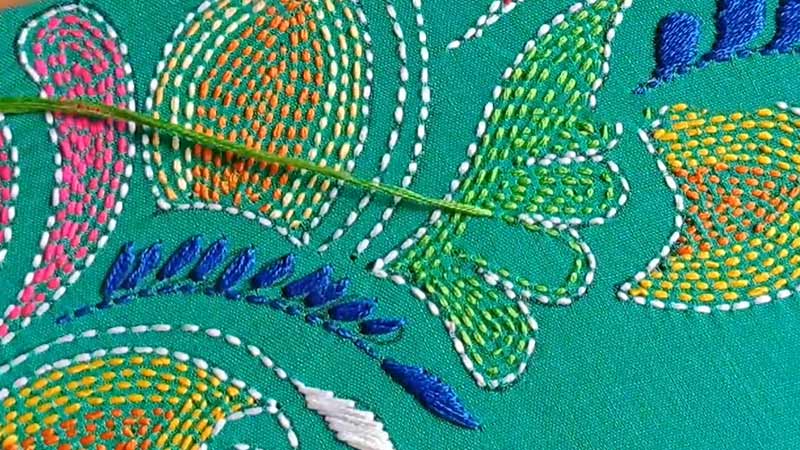
How Many Types Of Kantha Embroidery Are There?
Kantha embroidery, an ancient craft originating from the Indian subcontinent, boasts a rich tapestry of diverse styles and techniques.
Exploring the myriad types of Kantha reveals a kaleidoscope of stitching traditions, each with its unique history, symbolism, and aesthetic.
Let’s delve into the fascinating world of types of Kantha embroider designs, unraveling the threads that weave together its intricate narrative.
Baiton Kantha
Originating from Bangladesh, Baiton Kantha is recognized for its geometric patterns and symmetrical designs. The motifs often include flowers, animals, and architectural elements, creating a visually stunning effect.
This type of Kantha reflects the meticulous precision of Bangladeshi artisans and their inclination towards geometric symmetry.
Oaar Kantha
Hailing from West Bengal, Oaar Kantha is distinguished by its use of blue and white threads. The embroidery typically consists of repetitive geometric patterns, representing the waves of rivers or the undulating fields of rural landscapes.
Among all the different types of Kantha embroidery, Oaar Kantha stands out for its soothing color palette and rhythmic stitching, capturing the essence of Bengal’s serene countryside.
Sujani Kantha
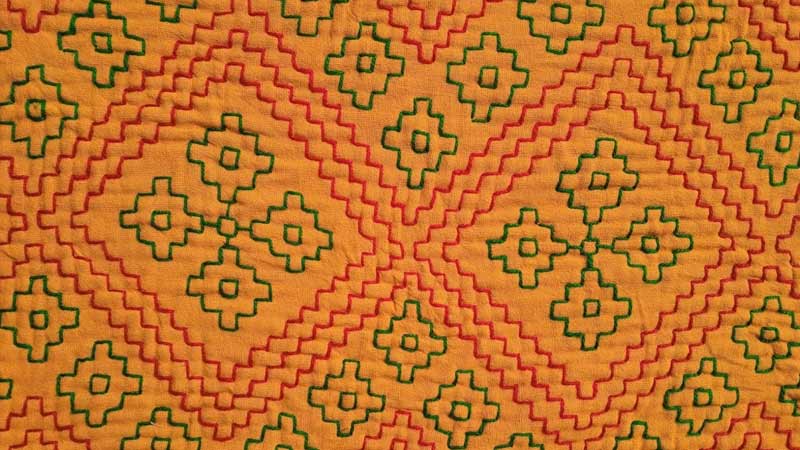
Sujani Kantha, characterized by its dense stitching and vibrant colors, is often associated with Bihar, India. Traditionally, this type of Kantha is crafted for special occasions and holds significance in rural households.
The meticulous embroidery on Sujani Kantha often depicts nature, mythology, or everyday life, portraying the artisan’s connection to their surroundings.
Archilata Kantha
Archilata Kantha, prevalent in the Murshidabad region of West Bengal, is characterized by its use of arch-shaped motifs. These arches are often embellished with intricate patterns, creating a visual spectacle.
Archilata Kantha pieces are revered for their ornate detailing and the skill required to execute elaborate arch designs.
Durjani Kantha
Hailing from the region of Rajshahi in Bangladesh, Durjani Kantha is renowned for its bold and contrasting color schemes.
Artisans skillfully blend vibrant hues to create visually striking patterns, often inspired by folk tales and local traditions. Durjani Kantha exemplifies the dynamic and expressive nature of this embroidery style.
Baiton Masi Kantha
Baiton Masi Kantha, a variation of Baiton Kantha, is specifically associated with the Maslandapur region of West Bengal. Artisans use contrasting colors to create intricate patterns that symbolize the community’s cultural identity.
Baiton Masi Kantha serves as a form of artistic expression and a means of preserving and transmitting cultural heritage.
Lep Kantha
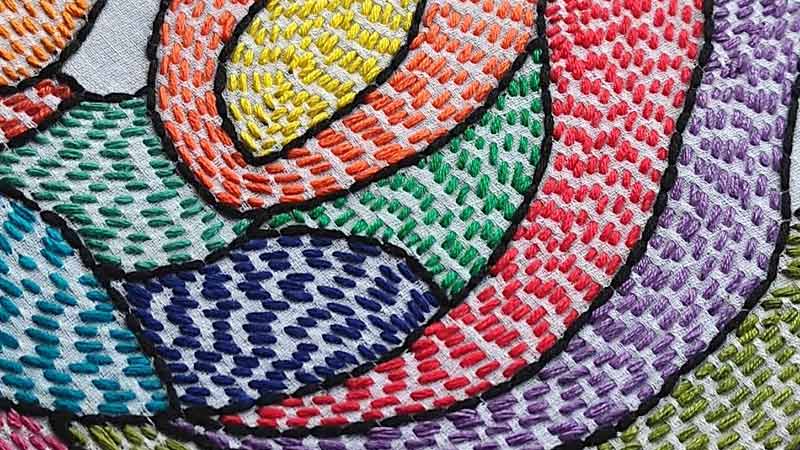
Lep Kantha, a traditional craft of the Rajbanshi community in North Bengal, is characterized by its use of small, tight stitches.
The embroidery is often done on old, worn-out sarees or dhotis, transforming them into beautiful and functional pieces. Lep Kantha serves as a sustainable and eco-friendly form of upcycling textiles.
Olti Gopalpur Kantha
Originating from the Gopalpur region of West Bengal, Olti Gopalpur Kantha is known for its diagonal stitch patterns. This distinctive technique creates a sense of movement and energy in the embroidery, making it visually dynamic.
Olti Gopalpur Kantha pieces often feature traditional motifs with a contemporary twist, showcasing the evolution of this ancient craft.
Sujni Kantha
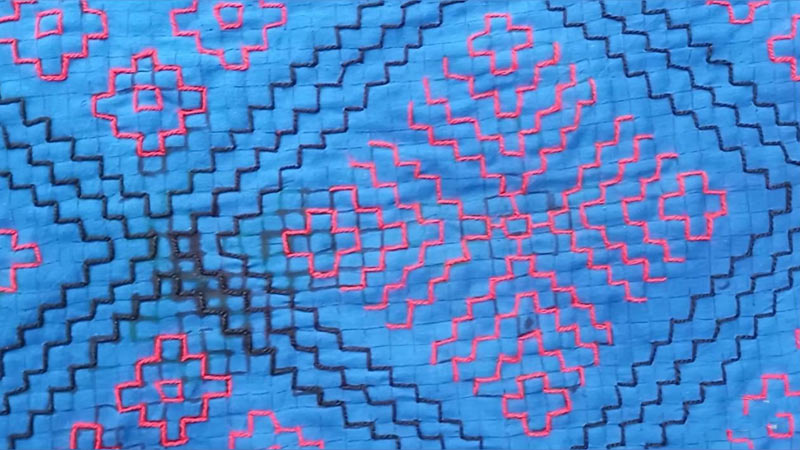
Sujni Kantha, prevalent in the Jharkhand region, is characterized by its simplicity and functionality. Traditionally used as quilts or blankets, Sujni Kantha pieces often feature sparse but purposeful stitching, reflecting the practical aspects of rural life.
The motifs in Sujni Kantha may include animals, plants, or everyday objects, emphasizing the connection to nature.
Ajrak Kantha
Ajrak Kantha, a fusion of Kantha embroidery and traditional Ajrak block printing, is prominent in the Kutch region of Gujarat.
Artisans combine the two techniques to create visually stunning pieces that blend the intricate patterns of Ajrak with the textured beauty of Kantha.
Ajrak Kantha reflects the artistic synergy between different craft traditions.
What Are the Types of Kantha Stitch?
Kantha embroidery encompasses various types of stitches that contribute to the beauty and texture of the final piece. Here are some key types of Kantha stitches:
Running Stitch
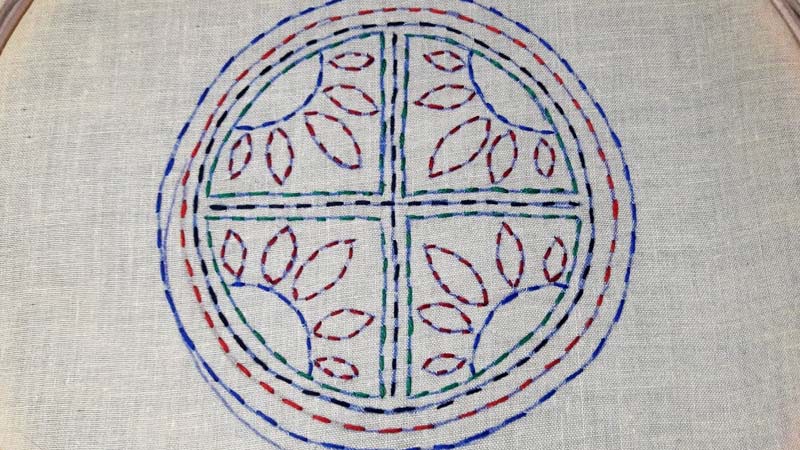
The most fundamental stitch in Kantha embroidery, the running stitch, involves passing the needle in and out of the fabric in a straight line. It forms the basis for other intricate stitches.
Holbein Stitch
Also known as the double running stitch, the Holbein stitch creates a solid, reversible pattern. It involves stitching two parallel lines and filling the spaces between them with additional stitches.
Sujani Stitch and Baiton Stitch
Specific to Sujani Kantha, this stitch is characterized by its dense, intricate patterns. Artisans use Sujani stitches to depict detailed scenes from nature, mythology, or everyday life.
This stitch is found in Baiton Kantha and often features geometric shapes and straight lines. It adds a precise and structured element to the overall design.
Cross Stitch
Involving two diagonal stitches forming a cross, this stitch is often used to create geometric patterns. Cross stitches contribute to many Kantha embroidery styles’ symmetry and visual appeal.
Zigzag Stitch
Zigzag stitches are used to create dynamic and energetic patterns. Olti Gopalpur Kantha, in particular, employs diagonal stitches to give the embroidery a sense of movement.
Long and Short Stitch
This stitch involves alternating long and short stitches to create a textured effect. It is often used in Kantha embroidery to add depth and dimension to the motifs.
Herringbone Stitch and Seed Stitch
Characterized by a series of slanted stitches resembling the bones of a fish, the herringbone stitch is used to create decorative borders and patterns in Kantha embroidery.
The seed stitch adds a delicate and subtle texture to the fabric by involving small, scattered stitches. It is often used in conjunction with other stitches for varied effects.
Blanket Stitch
This stitch, resembling the edge of a blanket, is commonly used to finish the borders of Kantha pieces. It not only secures the edges but also adds a decorative element.
Understanding these various stitches provides insight into the craftsmanship and artistry of Kantha embroidery types.
How to Do Kantha Embroidery? 14 Steps

Kantha embroidery involves a combination of simple stitches and vibrant designs. Whether you’re a seasoned artisan or a novice looking to explore this exquisite art form, here’s a step-by-step guide on how to do Kantha embroidery:
Step 1: Prepare the Fabric
Start by cutting the fabric to your desired size. If you’re a beginner, a smaller piece might be more manageable. Hem the edges to prevent fraying and secure the fabric in the embroidery hoop.
Step 2: Choose Your Design
Decide on the design you want to embroider. It can be a traditional motif or something of your own creation. Simple designs are best for beginners.
Step 3: Transfer the Design
Use a washable fabric marker or pencil to trace your design onto the fabric lightly. Alternatively, you can use an iron-on transfer or embroidery transfer pen.
Step 4: Select Your Thread Colors
Traditional Kantha often features vibrant and contrasting colors. Select threads that complement each other and enhance the visual appeal of your design.
Step 5: Thread the Needle
Cut a manageable length of thread (around 18-24 inches) and thread it through the embroidery needle. Knot one end securely.
Step 6: Start with Running Stitch
The running stitch is the foundation of Kantha embroidery. Bring the needle up from the back of the fabric and take it down a short distance away, creating a straight stitch. Repeat, keeping the stitches evenly spaced.
Step 7: Experiment with Holbein Stitch
For added intricacy, try the Holbein stitch (double running stitch). Stitch two parallel lines and then fill in the spaces between them with additional stitches.
Step 8: Explore Different Stitches
Experiment with other stitches like cross stitch, herringbone stitch, or zigzag stitch to add variety and texture to your design. Different Kantha styles may incorporate specific stitches unique to their tradition.
Step 9: Fill the Design with Stitches
Continue stitching, gradually filling your design with the chosen stitches. Pay attention to color placement and stitch density to bring your design to life.
Step 10: Blend Colors Thoughtfully
Blend and transition between colors used in Kantha Embroidery. This is where your artistic flair comes into play. Traditional Kantha often features intricate color combinations, adding depth and vibrancy.
Step 11: Add Layers for Complexity
To add complexity to your Kantha embroidery, consider adding layers of stitches. You can create shading effects or highlight specific areas by layering stitches in different directions.
Step 12: Secure the Ends
Secure the ends by weaving them into the back of the stitches when finishing a thread or changing colors. This ensures a neat appearance and prevents unraveling.
Step 13: Embrace Imperfections
Kantha embroidery celebrates the handmade and embraces imperfections. Don’t be afraid to experiment and let your creativity flow. The uniqueness of each piece adds to its charm.
Step 14: Final Touches
Once you’ve completed your design, remove the fabric from the hoop and give it a gentle press. Admire your finished Kantha embroidery masterpiece.
Remember, Kantha embroidery is not just a craft; it’s an art form allowing self-expression and creativity.
FAQs
What is the origin of Kantha embroidery?
Kantha embroidery originated in the Indian subcontinent, particularly in regions like Bengal and Bangladesh. It has a rich history, with roots tracing back to rural communities’ daily lives and cultural practices.
Are there specific motifs used in Kantha embroidery?
Yes, Kantha embroidery often features a variety of motifs, including floral patterns, geometric shapes, animals, and mythological symbols. The choice of motifs can vary based on the region and cultural influences.
Can Kantha embroidery be done by beginners?
Absolutely. Kantha embroidery is known for its simplicity and versatility. Beginners can start with basic stitches like the running stitch and gradually explore more intricate techniques as they gain confidence.
What materials are commonly used in Kantha embroidery?
Cotton is a popular choice for the fabric used in Kantha embroidery due to its ease of stitching. Fine embroidery needles, colorful threads, an embroidery hoop, and a design template are essential materials for anyone practicing Kantha embroidery.
Are there different styles of Kantha embroidery, and how do they differ?
Yes, there are various styles of Kantha embroidery, each with its unique characteristics. For example, Sujani Kantha is known for its dense stitching and vibrant colors, while Baiton Kantha often features geometric patterns. The styles differ regarding the region, stitches used, and the cultural influences that shape them.
Conclusion
In the intricate world of Kantha embroidery, we’ve embarked on a journey highlighting the diversity and artistry embedded in each stitch.
As we conclude our exploration, it becomes evident that Kantha is not merely a craft but a living tradition, weaving stories of generations past into every textile masterpiece.
The rich array of Kantha types, from the symbolic narratives of “Baiton Kantha” to the rustic charm of “Archilata Kantha,” showcases the adaptability and creativity of artisans.
In embracing these variations, we celebrate the resilience of a craft that transcends time and borders, connecting us to the cultural heritage of South Asia.
The enduring allure of Kantha embroidery lies not just in its visual appeal but in the preservation of narratives, making each piece an ornament and a testament to the artisans’ skill, imagination, and the enduring spirit of tradition.
Leave a Reply